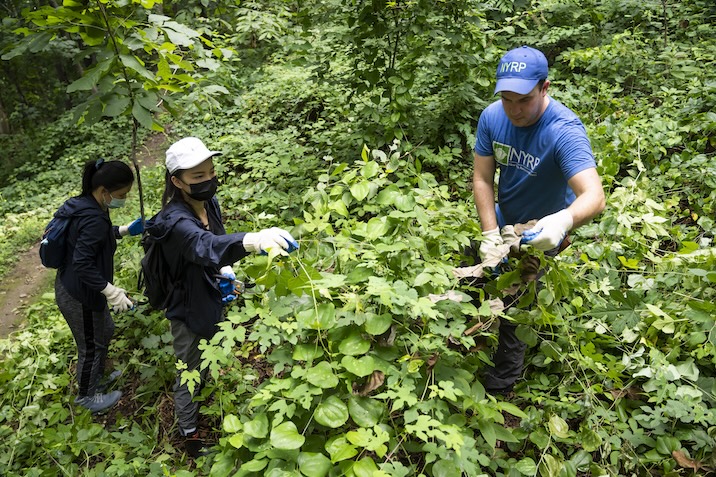Annual Report | March 28, 2024
Annual Report 2023: Restoring Parkland
 NYRP vigorously monitors and removes invasive
species in more than 80 acres of Northern
Manhattan parkland. They can suffocate entire
forests when left unchecked.
NYRP vigorously monitors and removes invasive
species in more than 80 acres of Northern
Manhattan parkland. They can suffocate entire
forests when left unchecked. The following blog post is an excerpt from our 2023 annual report.
The NYC Parks Department budget has been less than 1% of the entire city budget since the fiscal crisis of the 1970s. Even though the department is responsible for more than 14% of the city’s total land area, severely inadequate operating funds have constricted their operations for decades.
While the fight for municipal park resources is ongoing, nonprofit groups like New York Restoration Project have forged public-private relationships for years to help bridge the resource gap. Thanks to our longstanding partnership with NYC Parks, we have initiated and overseen the transformation of dozens of acres of parkland since our founder Bette Midler began picking up trash in Northern Manhattan in 1995.
Today in Washington Heights and Inwood, NYRP is the primary steward of over 80 acres of green space across Highbridge Park, Sherman Creek Park, and the Harlem River Greenway. Once littered with tires, abandoned cars, and mountains of trash, NYRP has led extensive ecological restoration efforts to revitalize these important urban forest and wetland ecosystems for almost 30 years.
Invasive species removal and tree planting and care are key strategies in NYRP’s long-term investment in these historically underserved landscapes. With the help of hundreds of corporate and community volunteers this past year, we planted more than 1,000 trees and shrubs throughout our parks, which included reforesting 2.5 acres in Highbridge. “This is an area where we essentially created forest,” says NYRP Director of Northern Manhattan Parks Jason Smith.
One of our most dynamic restoration projects is on the Harlem River shoreline at Sherman Creek Park. This waterfront park is part of the last remaining salt marsh environment predating European settlement on the entire perimeter of Manhattan.
In response to years of erosion and decline of the historic marsh, NYRP collaborated with NYC Parks in 2020 to successfully install a living shoreline: a 500-foot artificial oyster reef with expanded marsh grass plantings. This project helps protect the park from sea level rise and wave action, provides habitat for wildlife, and serves as an example of nature-based climate adaptation.
The project’s growth and development have been thrilling to watch; the new marsh is already matching the existing marsh in its capacity to remove nitrogen pollution, which is primarily caused by sewer discharges, from the river. Furthermore, previous work has shown that the restored marshes in Sherman Creek Park rival or exceed nearby unrestored marshes in this critical ecosystem service.
Additionally, the marsh’s rapid growth represents carbon dioxide—the primary cause of the climate crisis—that has been removed from the atmosphere at the site, some of which will be stored in the marsh sediments. This contributes to long term carbon sequestration at the site if we keep our marshes thriving.
“For a newly restored marsh to have this level of function is genuinely surprising,” observes Jason. “In addition to keeping the shoreline intact, our project is removing some of our most harmful pollutants from our local urban environment, too.”